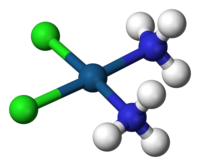
Photo from wikipedia
The stepwise addition of Cu2+ ions to the nonplanar cyclic Schiff base 5,9,14,18-tetramethyl-1,4,10,13-tetraazacyclooctadeca-5,8,14,17-tetraene-7,16-dione (H4daaden, C18H28N4O2), yields a one-end-open dinuclear copper chelate. The pyridine adduct of the dinuclear copper chelate, namely,… Click to show full abstract
The stepwise addition of Cu2+ ions to the nonplanar cyclic Schiff base 5,9,14,18-tetramethyl-1,4,10,13-tetraazacyclooctadeca-5,8,14,17-tetraene-7,16-dione (H4daaden, C18H28N4O2), yields a one-end-open dinuclear copper chelate. The pyridine adduct of the dinuclear copper chelate, namely, [μ-6,11-dimethyl-7,10-diazahexadeca-5,11-diene-2,4,13,15-tetraolato(4-)](pyridine)dicopper(II), [Cu2(C16H20N2O4)(C5H5N)], was characterized by single-crystal X-ray crystallography. The two CuII atoms of the copper chelate display different coordination modes, i.e. inner-N2O2 and outer-O2O2. The Cu atom which is bonded in the outer-O2O2 mode is axially bonded to a pyridine molecule, which suggests that the electron-donating ability of the O2O2 site to the Cu atom is poor. As a result, the O2O2-bonded Cu atom has a coordination number of five, showing square-bipyramidal geometry around the Cu atom. The N2O2-coordinated site provides sufficient electron density to the other Cu atom to be stabilized with a coordination number of four, showing square-planar geometry around the Cu atom. The electron-donating ability of the ligand coordination sites plays a key role in determining the coordination number of the Cu atoms of the dicopper chelate.
Journal Title: Acta crystallographica. Section C, Structural chemistry
Year Published: 2023
Link to full text (if available)
Share on Social Media: Sign Up to like & get
recommendations!